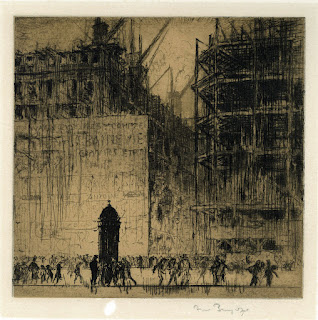Frank Brangwyn 1867- 1956
I first came upon the work of Frank Brangwyn during an
Australian artist residency at the famous Cite des Arts in Paris. While away for a few days I visited Bruges
in Belgium and happened upon the Frank Brangwyn museum. While there I viewed his etchings (and
other works) for the first time. I had no idea then who Brangwyn was or that he
spent much of his life in the UK as a successful artist and teacher.
I also
did not realise then that he had a direct influence on Australian printmakers from works of his that made their way here as well as through one of his then student, Jessie Traill (who studied with him in London
in 1907) and became one of the ground breaking printmakers of Australia.
 |
| Frank Brangwyn, The Last of H.M.S. Britannia, 1917 etching (55 x 80.5 cm) |
I have always been struck by the scale and raw energy of Brangwyn's etchings as
well as his gestural but accurate use of line. Like Piranesi he often highlighted
the grandeur of architecture and machinery against the minuteness of the human
form.
This relationship gave his work
its sense of scale. Some structures seemed to have an anthropomorphic aspect and seemed like huge beasts that the small figures were interacting with.
 |
| Frank Brangwyn, A Procession Genoa, 1924 (25.8 x 23.5cm) |
I was also intrigued
by the under wiped plate tone he used to add tonality and depth to otherwise
clean areas of the plate. This also gave an individual quality to each print
that he pulled from the press.
 |
| Frank Brangwyn, Building the New Bourse, Paris, 1919 (17.6 x 18.1cm) |
Many of the Brangwyn etchings in my collection came from
other collectors in Australia. He was obviously an artist that has built up a network
of admirers throughout the world. In spite of this I believe Brangwyn is a
seriously underrated artist whose work is still very affordable but whose works
will one day be better known.
 |
| Frank Brangwyn, The Moat, 1913 (30.1 x 40.3 cm) |
is for me one of the great Brangwyn etchings. This large work made in 1906 has a monumental feel because of the sculptural nature and positions of the drawn figure group. It shows six men straining on ropes which are pulling a barge which is not visible in the etching. The men are seen working as one to complete their grueling task. The etching is charged with emotion and reveals many attributes that followed later in the prints of the German expressionists.
 |
Frank Brangwyn, The Tow-Rope 1906 (54.3 x 80.8 cm)
|
Temporary Wooden Bridge at Ghent is another large Brangwyn etching which the artist from an earlier larger plate that he maned initially as Old Houses Ghent in 1906. Brangwyn reworked parts of the left hand side of the plate before making a new edition in 1920. The etching itself is difficult in parts to define and because of this the figures take on a mysterious persona.
 |
| Temporary Wooden Bridge at Ghent, 1926 (55.5x60.9cm) |
Frank Brangwyn used many different printmaking mediums including lithography. This example of a station although small reveals a sense of grandness because of its low view point as well as its use of scale in contrast to the small figures on the street below. The use of strong light also helps to give a theatrical quality to the image.
 |
Frank Brangwyn, The Station, 1919, Lithograph, (19.6x16.6cm)
|
This plate was etched from a watercolour Brangwyn made of the Church and tower of St Nicholas in Paris. The Church stands on the corner of rue des Bernardins and rue St Victor. Like many other large Brangwyn etchings of architectural forms the human figures is used to contrast the grandness of the Church. The plate is under-wiped in parts to provide extra tone in specific areas.
 |
| Frank Brangwyn, Church of St Nicholas, 1913, (52x63.1) |








No comments:
Post a Comment